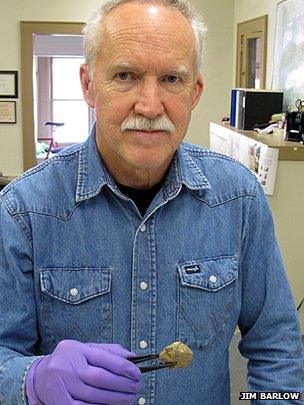Oregon stone tools enliven 'earliest Americans' debate
- Published

Western Stemmed points differ significantly from Clovis design at their base
Scientists studying how North America was first settled have found stone spearheads and darts in Oregon, US, that date back more than 13,000 years.
The hunting implements, which are of the "Western Stemmed" tradition, are at least as old as the famous Clovis tools thought for a long time to belong to the continent's earliest inhabitants.
Precise carbon dating of dried human faeces discovered alongside the stone specimens tied down their antiquity.
<link> <caption>Science magazine has the full report</caption> <url href="http://www.sciencemag.org/content/337/6091/223" platform="highweb"/> </link> .
It has published the scholarly findings of an international team investigating the Paisley Cave complex in south-central Oregon.
Researchers, led by Dennis Jenkins, describe a range of projectile points discovered 1-2m (3-7ft) down in the cave sediments.
"Mostly, we're looking at discards; these are broken and left behind," said the University of Oregon archaeologist.
"Most of these appear to be dart points and have been cast at an animal and broken in the process of being used," he told reporters.
Human faeces
Western Stemmed projectile points differ from comparable Clovis tools at their base, which reflects the way they were shaped and attached to a wooden shaft.
Previous examples found at dig sites in the western US and which have been reliably dated would suggest the technology is more recent than the Clovis tradition.
But Jenkins' group has been able to show the Paisley artefacts were being used contemporaneously to, and perhaps even before, the other cultural tradition.
To do this, the scientists employed state-of-the art radiocarbon dating techniques on human coprolites - desiccated excrement - found in the same layers of the cave's sediments.
"These coprolite samples were all taken under very controlled conditions," explained Eske Willerslev, from the University of Copenhagen, Denmark.
"When they were discovered in the sediments, people with full body suits, face masks and gloves took the coprolites out and put them into a sterile container."
The samples were sent to independent labs to establish their status - their age and DNA content.
'Clovis first'
Multiple tests placed the coprolites and, by association, the oldest projectile points at 13,200 years before the present day - concurrent with our time estimates for the use Clovis technology in other parts of North America.

Dennis Jenkins holds a human coprolite dating to about 13,000 years ago
The scientists did date Paisley faeces as far back as 14,500 years ago, but no stone tools were found alongside those specimens, and so no really firm conclusions can be drawn about whether Western Stemmed points predated Clovis.
"We've got people in the cave at [14,500 years ago]; we have them showing up again right down through 13,000 years [ago], and there's no evidence of Clovis or precursor to Clovis. Therefore, the most likely answer is that it's Western Stemmed - but we have not proven that," cautioned Prof Jenkins.
For decades, it was assumed that the people associated with Clovis technology were the first human inhabitants of the New World - that they were the ancestors of all the indigenous cultures of North and South America.
It was argued that they crossed from Siberia into Alaska via a land bridge which became exposed when sea levels dropped about 13,500 years.
But this narrative has lost its currency in recent years as more and more evidence has emerged of earlier occupations - some of them confirmed to 15,000-16,000 years ago.
The new Paisley finds further undermine the simplistic "Clovis first" model.
Genetic studies
No-one really knows if the humans using Western Stemmed weaponry represented a completely separate immigrant population to those using Clovis technology, but clearly the traditions of the two groups are different - and it is impossible now for anyone to argue that Clovis is some sort of precursor to Western Stemmed.
What seems to be emerging is a much more nuanced story of how modern humans came to settle in the Americas.
<link> <caption>Genetic research published by the journal Nature this week</caption> <url href="http://www.bbc.co.uk/news/science-environment-18770963" platform="highweb"/> </link> would indicate that the peopling of the Americas from Asia/Siberia occurred in at least three major streams - that modern Native American populations cannot trace their ancestry to a single immigration.
The Jenkins study in Science has something to add to this analysis through the DNA pulled out of the coprolites, although the location in human cells from where that material is derived limits its scope, concedes Prof Willerslev.
"The haplogroups, or the DNA types, are similar to what you find among certain Asian groups, also among [modern] Native American groups. So, in terms of the mother line, this definitely suggests that [the Paisley Cave] people are Asians in origin and possibly - it's not 100% certain - could be ancestral to Native Americans."
- Published21 October 2011
- Published24 March 2011
- Published4 March 2011